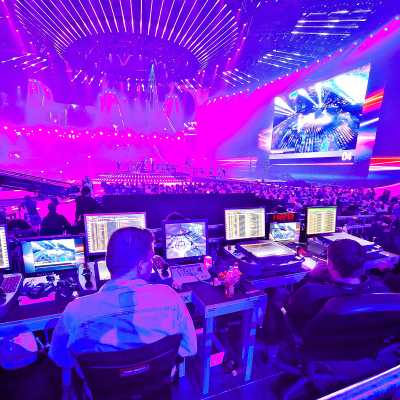Video and Media Integration Unit
Video and Media Integration Unit Description

Video and media integration for events and live performance is the use of audiovisual and media technology as it applies to the performer, sets, products or the event or performance space. This includes presenting video or media content through projection techniques or by using monitors or other display technologies, loudspeakers and audio devices as well as the creation of audiovisual or media content for use in the sector. This can also include IT-based data communication.Many different special types of audiovisual technology are used in this vocation.
The personnel who install, operate, and control the equipment are commonly referred to as video technicians. The equipment used can be found in many event and live-performance settings, including the theatre, corporate events, concerts, trade shows, broadcast television and other types of live events.
The competences listed in TeBeVAT are common for video technicians in all areas of video and media integration in the sector.
Photo © Ralph Larmann
Scope note
ESCO: essential skills/competences of
Video Technician
Stage Technician
Performance Video Operator
Performance Video Designer
Competences
The Work Organisation Unit competences are a prerequisite as a basis for all units.
Planning (10)
30 00 10 03 10 - Translate artistic concepts to technical designs (Cooperate with the artistic team in order to facilitate the transition from the creative vision and its artistic concepts to a technical design.)
70 20 10 04 30 - Plan teamwork (Organise the working schedule of a group of people in order to meet all time and quality requirements.)
70 30 10 05 10 - Develop project schedule (Define the project completion stages and create a timeline. Synchronise necessary activities, taking into account the convergence of production elements. Establish a schedule.)
80 00 10 04 10 - Advise client on technical possibilities (Apply one's expertise of technical systems to advise the client about the possibility or specifics of a project.)
Preparing (20)
05 00 20 04 10 - Install image equipment (Set up, install and connect projection and image equipment.)
05 00 20 04 20 - Adjust projector (Modify the controls of projection equipment to obtain a clear and well‐positioned image)
05 10 20 03 10 - Set up cameras (Put cameras in their specified places and prepare them for use.)
15 50 20 04 10 - Pack electronic equipment (Safely pack sensitive electronic equipment for storage and transport.)
30 00 20 04 10 - Adapt existing designs to changed circumstances (Alter an existing design to changed circumstances and ensure that the artistic quality of the original design is reflected in the final result.)
30 00 20 04 15 - Adapt artistic plan to location (Accommodate plans to other locations with respect for the artistic concept.)
30 00 20 04 20 - Support a designer in the developing process (Provide assistance and support to designers throughout the course of the development process.)
70 51 20 04 10 - Check material resources (Verify that all requested resources are delivered and in good working order. Notify the appropriate person or people of any problems related to technical and material resources.)
Rehearsing (30)
30 00 30 03 10 - Adapt to artists' creative demands (Work with artists, striving to understand the creative vision and adapting to it. Make full use of your expertise and capabilities to reach the best possible result.)
Running the Show (40)
00 00 40 03 10 - Communicate during show (Interact efficiently during a live performance, in order to anticipate any possible malfunctionings).
03 10 40 03 22 - Follow time cues (Observe the conductor, orchestra or director and follow text and vocal scores to time cues accurately.)
05 00 40 04 20 - Run a projection (Operate projection equipment safely and efficiently to project images on a background in an artistic or cultural context.)
05 10 40 05 20 - Mix live images (Follow video streams of a live event and mix them together using specialised equipment and software.)
After the Show (50)
00 00 50 03 10 - De‐rig electronic equipment (Remove and store various types of electronic equipment safely after use).
00 00 50 03 20 - Store performance equipment (Dismantle sound, light and video equipment in a safely manner after a performance).
15 20 50 04 10 - Pack electronic equipment (Safely pack sensitive electronic equipment for storage and transport.)
Maintenance (60
05 00 60 04 10 - Maintain audiovisual equipment (Perform routine maintenance tasks on audiovisual equipment as well as minor repairs, such as replacing parts and calibrating the instruments, on equipment used in processing sound and images.)